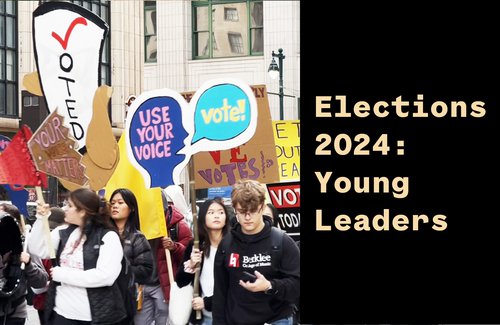
Tuesday, November 4, 2024 will be a big day– with millions of U.S. voters headed to the polls to choose leaders at the local, state, and national levels– including casting votes for president.
Although many politicians are from older generations, young people are getting involved and making their voices heard. For this project, tell a story about a young person who is participating in the 2024 elections.
Gen Z candidates are now running for office, and teens and young adults are volunteering for campaigns, knocking on doors and working at the polls on election day.
In 2022, youth voter turnout was one of the highest levels in a midterm election since the voting age was lowered to 18, according to the Center for Information & Research on Civic Learning and Engagement (CIRCLE) at Tufts University.
This year, instead of submitting fully produced stories, SRL invites students to pitch their story ideas first.
PRO TIPS BEFORE BEFORE PITCHING YOUR STORY:
SUBMIT YOUR PITCH:
SUCCESSFUL PITCHES WILL:
If your pitch is selected, you will work with an SRL Youth Media Producer to further develop your story for publication. A team member will contact you within three weeks of your submission.
Journalism is the activity of gathering, assessing, creating, and presenting news and information.
A subject or problem that people are thinking and talking about
A group of people who live in the same area (such as a city, town, or neighborhood). It can also be a group of people who have the same interests, religion, race, etc.
A simplified and standardized conception or image invested with special meaning and held in common by members of a group; a set form or convention
Immediate, current information and events are newsworthy because they have just recently occurred. It’s news because it’s “new.”
Investigating and explaining, in a critical and clear-eyed way, how people try to solve widely shared problems. Solutions journalism focuses on responses to problems.
People are interested in other people. Everyone has something to celebrate and something to complain about. We like unusual stories of people who accomplish amazing feats or handle a life crisis because we can identify with them.
In news, it’s a story’s point or theme. It's the lens through which the producer or writer filters the information they have gathered and focuses it to make it meaningful to viewers or readers.
The people who read, watch and consume news. Often, journalists think about audience and newsworthiness in similar ways. How will the news story serve their local or national audience? Who am I writing the story for and why?
A person or other physical being in a narrative. Stories are made up of different characters who provide information and help shape the narrative with their knowledge, experience and perspective.
A description of what your story might be and WHY it’s important. An outline of your story idea and the steps to achieve your goal. A summary of what you hope to accomplish in your story
Video stories about newsworthy issues and topics, factual information, balanced reporting, research, voice overs, soundbites, b-roll footage, infographics, reporter standup, nats (natural sound bites).
The story of one person, has voiceover (VO), b-roll, pictures, nats (natural sound), interviews of family members or peers of that one person.
Narration and/or voiceover (VO) with a host, commentary, research, personal experiences, explanations, infographics, nats (natural sound), music, entertainment.
A short video clip that captures the interview subject in their natural state. It involves a person looking into the lens for a few seconds. It’s like a still photo but video!
An investigation into and study of sources in order to establish facts and reach new conclusions.
A source is an individual, company, document or more that can provide information to fuel a new story. In order for a story to be considered verified and to maintain a reputation as a news outlet, it is important to have a credible source.
An example of using a little person to tell a big story. For example, you want to tell a story about pollution in your community’s water system. That is a big issue. Your video will use the story of a person (character) to illustrate the effects of bad water quality.
An attempt to grab the reader or viewer’s attention with interesting information that will keep them reading or watching.
Free from mistake or error. Coverage of topics and facts in appropriate detail.
Historical understanding requires recognizing this multiplicity of points of view in the past, which makes it important to seek out a range of sources on any historical question rather than simply use those that are easiest to find. It also requires recognizing that perspectives change over time, so that historical understanding requires developing a sense of empathy with people in the past whose perspectives might be very different from those of today. (NCSS D2.His.4.9-12 - D2.His.8.9-12)
Students leverage technology to take an active role in choosing, achieving, and demonstrating competency in their learning goals, informed by the learning sciences. (ISTE)
Determine the kinds of sources that will be helpful in answering compelling and supporting questions, taking into consideration multiple points of view represented in the sources, the types of sources available, and the potential uses of the sources. (NCSS D1.5.9-12)
Whether students are constructing opinions, explanation, or arguments, they will gather information from a variety of sources and evaluate the relevance of that information. (NCSS D3.1.9-12 - D3.2.9-12)
Journalism
Representation
Stereotypes and Misconceptions
Civics
History
Active Prompts
Beginner
Intermediate
Computers
Internet
4-6 Weeks